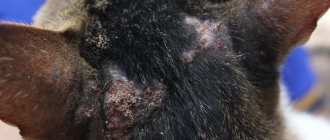When cats hiss at kittens
Watching a cat hissing at kittens, you can notice that often its visible aggression in this case is a kind of lesson. It is not uncommon for babies to be trained in the form of outwardly aggressive play, in which mother and kittens mutually attack each other. In this way, babies gain the skills they need in the future to defend themselves and provide food for themselves.
© shutterstock
When playing, the cat growls, hisses and looks very intimidating, but her aggression is not directed against the kittens, she tries to recreate possible life situations. You should not interfere with their game. If you try to take the cub, the mother may hiss at you. This defense of the kittens by hissing is her natural reaction in the current situation.
Leadership in the cat family
When kittens switch to adult food and learn to defend themselves, they become independent and enter adulthood. During this period, they cease to be cat children and become competitors for the attention of their owners, for the best tidbit, for territory. In cats, hierarchy is very important.
When kittens switch to adult food, they become independent and enter adulthood.
By hissing, biting, and persecuting, the older cat asserts its dominance, the right to territory and the care of its owners.
At this age, it’s time to separate the cat and kittens and find a new home for the kittens. In special cases, you can try to endure and let them figure out for themselves who will be at what social level and themselves obey the subsequent rules established by the animals.
Alien smell
Changing the smell of kittens, as a result of our indiscretion in handling babies, can disturb the cat and cause an aggressive reaction in it. A person, holding a kitten in his hands for just a little while, changes its smell. The mother may not recognize him and may even growl at him in order to drive him away. However, as a rule, the mother licks the kitten to return its characteristic smell.
If the cat hisses at the kitten and does not want to accept him, you need to try to return him to the smell familiar to his mother. To do this you can :
- wrap it in your mattress for a while;
- put next to the rest of the kittens;
- rub his fur with mom’s toy.
After some time, the kitten will get rid of the foreign smell and the cat will stop hissing at him and recognize the cub. But it is possible that the mother will reject the baby because of the foreign smell, as if he is not from her offspring. For this reason, it is not recommended to handle small kittens.
Weaning time
All little kittens grow into big beautiful cats. But sometimes they lose sight of the fact that it is time to move away from their mother. She is tired of feeding her children 24/7. Ultimately, she wants to expand her horizons and spend more time by herself, lounging in her favorite chair and dozing all day long. Therefore, the mother cat may hiss and growl to calm herself down a little. When it's time to wean—usually around 6 weeks after giving birth—the cat will let her babies know through this behavior.
New pregnancy
In cats, the period between conceptions can be quite short. If she had the opportunity to leave the house, then a second pregnancy is not excluded. Then she will not be able to feed the kittens and will try to get rid of them. Expecting new offspring, the cat will show aggressiveness towards her kittens and will hiss at them in an attempt to drive them away. In this situation, it is necessary to isolate the kittens from their mother and feed them from a pipette or nipple.
© shutterstock
Aggression in a cat: why does it happen?
Cats tend to be possessive, even if they have spent their entire lives sharing a home with other pets. However, if one of the pets takes it to the next level and makes life difficult for the other cat, it's no longer just a game.
Paying close attention to your cat's body language can help identify signs of aggression:
- Gaze.
- Hiss.
- Biting.
- The pursuit.
- Scratch.
- Aggressive stance, arched back, fluffy tail, curled or flattened ears, dilated pupils.
In some cases, the cause of a cat's attack of aggression is obvious: meeting a new cat or other pet, or even the appearance of a newborn baby in the house.
More obvious types of aggression - such as biting, attacking, etc. - often result in physical harm. But aggression is usually aimed at asserting its dominant position, and not at intimidation.
As the American Association of Cat Practitioners notes, “Aggressors can control another animal’s access to food, litter boxes, resting and sleeping areas, and attention from owners, which usually results in isolation of the victim.” If you don't pay close attention, you may not even notice the signs of bullying.
Mature kittens
Cats are very sensitive not only about territory, but also jealously protect their offspring. If the mother shows aggressiveness towards the kittens, then there is a good reason for this :
- She might be sick.
- There is no milk.
- The kittens are already teething and they are causing her pain.
- The kitten is weak, not viable, she does not allow him to have a pacifier so that there is more milk for the rest.
Cats sometimes nurse kittens for up to a year, but most often the maternal instinct lasts for up to six months. After which the mother refuses to feed them, showing that they have already grown up enough and it’s time to cope on their own. You notice that the cat has begun to hiss at her kittens.
No matter how cruel such behavior may seem to a person, it has a good reason. When a cat hisses at her own kittens, this does not mean she is cruel, it’s just that ancient instincts that guide her have awakened in her. You can't punish her for this! A cat's hissing at kittens always has a good reason.
At this moment, the babies must be given to another owner. If you want to keep one of them for yourself, you need to monitor the behavior of your pets, since the mother, emphasizing her primacy in the hierarchy, may be aggressive towards the baby. In this situation, she will not only hiss at the kitten; more aggressive actions are also possible. After a couple of weeks, the cat will calm down, take a position and stop hissing at the kitten.
© shutterstock
The cat is just tired
Your mother cat “works” around the clock, taking care of all her babies, feeding them, making them go to the toilet, washing them and teaching them how to use the litter box. She was just terribly tired!
The moment the cat starts hissing, she is telling her young children, “Hey, I need a few minutes of me time. Take a nap or go play. Now!" This is normal behavior and does not mean that babies need to be separated from their mother. If the owner tries to do this, he will certainly receive several painful scratches for his actions.
My cats suddenly started fighting. What should I do?
If cat aggression results in a fight, the best solution is to separate the animals and place them in different rooms for 1-2 days until they calm down. Repeating active hostilities at the next encounter will require separating the pets for a longer period. In this situation, cats should be perceived as strangers seeing each other for the first time.
Sometimes manifestations of aggression happen at the most inopportune time, when a person is not ready for sudden conflicts. For example, a group of animals may react negatively to the return of a cat that has undergone surgery at the veterinary clinic.
Communication in the cat community is carried out primarily through smell; With their help, animals separate their own from strangers. From the clinic, the cat brings with it a mixture of unpleasant and even threatening “odors.” This misleads the members of her “group”, who are unable to recognize the cat as a companion. To avoid hostility in the cat family, an animal that has been to the veterinarian should be isolated in a separate room for at least 12 hours (or overnight). This time should be enough for the pet to lick the fur and “return its native scent.” By stroking and showing your love in every possible way, you can help the cat stabilize its emotional state, but it is important to be careful when handling the operated animal. It would be a good idea to get care instructions from your veterinarian.
My pet bit someone else's cat. Do I have to pay for treatment?
Although aggression is normal among felines, serious incidents can lead to disputes between cat owners (especially if the aggressor attacks multiple animals). Sometimes the showdown gets so bad that police intervention is required. At the legislative level, each country solves this problem in its own way. In the UK, for example, there are precedents for assigning sums of money that owners of tyrannical cats had to pay to the injured party as damages.
Based on materials from icatcare.org
Bites as a method of raising offspring
A cat who has become a mother faces a difficult task: she needs to teach her litter everything she knows in the shortest possible time. This is required so that the kittens are ready for independent living. Moreover, in the wild, such activities would ensure their survival. At the same time, cats have much less time at their disposal than people have to raise their children.
You don't have to worry if your pet bites the kittens without leaving marks on their skins. As a rule, educational biting lasts until the baby makes a loud cry. With his voice, he lets his mother know that he understands everything, and, satisfied with this signal, she lets him go.
Prepare the house
New items for your kitten, such as food bowls, beds, another litter box, toys, should be placed in the house before the kitten arrives home.
Start placing items in new locations about a week before arrival so your adult cat can smell them and get used to them. If you can, try bringing items that already have kitty scent on them.
Make sure you are ready to adopt a kitten yourself.
If you are stressed and unprepared, your adult cat will be able to tell and be negatively influenced.
Designate a small room, such as a bathroom, for your new kitten to have privacy in for the first week or so. Your older cat should be able to reach the door of this room to hear and smell the kitten, but not have any interaction with it.
Place the kitten's belongings (such as a litter box and food bowls) in this room along with a toy that belongs to the older cat.
How to distinguish a fight in a game from a real conflict?
Many cats that have a close bond enjoy playing together. They fight, rush around the apartment, roll around in a ball and hit each other with their paws. Play wrestling often takes place silently with breaks during which the participants change positions. Such fights do not bring pain, because... the animals retract their claws and strike carefully. At this stage there is no need to separate the pets. In some cases the struggle may intensify; Hissing and squealing indicate that the animal’s partner’s actions are beginning to cause discomfort. After joint activity, the cats quickly return to their normal state, and there is no tension in further relationships between the participants in the play fight.
How to reduce the risk of aggression and raise an affectionate animal
An affectionate animal can only grow up in a caring and loving family. Never, under any circumstances, use physical punishment. Your hands should only be associated with affection.
Try to talk with your pet often and study its habits. If dissatisfaction appears, accompanied by warning signals, do not test his patience, but immediately stop the unpleasant actions.
If a cat grows up next to a child, make sure that the child knows how to handle it carefully. Stop sudden grabbing and squeezing.
How to solve the problem of attacks between cats
There are many possible reasons why your cat might attack another cat, including lack of space, social maturity, health issues, or environmental changes. Fortunately, solutions can generally be found to allow cats to continue living together and overcome their aggression .
Since you can't simply ask your cats what's wrong with each other, determining the cause of aggression is usually a process of elimination that simply involves trying different solutions.
Keep in mind that if this behavior starts after the cats have been together for a while, there may be a health problem behind it. When a cat is in pain or discomfort, it may show signs of aggression, even if it is usually docile. Once medical problems have been ruled out, other methods can be used to reduce aggression between cats.
Let cats have their own space
Cats love to have their own space and can be quite territorial. Sharing small spaces, food bowls, and toiletries is a common cause of aggression. While you won't be able to expand your home, you can add space for cats by installing additional perches , cat apartments, or even investing in an outdoor cat enclosure that allows cats to safely spend time outdoors.
Also, provide food bowls, water bowls, and litter boxes (one litter box per cat, plus one extra litter box is best!) for each pet so the cats don't have to share. You can buy new material you need link .
Provides an escape that cats love
If your cat tends to be passive, install a cat door with a collar or latch that leads to a quiet room. Simply place the collar on a cat that is being bullied or allowing a passive cat to enter. Leave another one. This will allow you to escape from the aggressor and give the pursuing cat a cooling-off period. .
Pheromones
FELIVEY Classic -… No ratings
20,89 €
View offer View features
Many cat owners have had great success using pheromones to prevent one cat from attacking another. These products, which come in the form of sprays and diffusers, calm cats and in some cases are a very effective way to get rid of fighting. You just need to ask your veterinarian which product is best for you.
Waiting time
Does absence make love grow? Maybe not, but it will give you the opportunity to get your cats back to normal slowly and properly. Wait until cats recognize your scent before gathering them in the same room. This way they will be calmer when they get together and won't feel threatened. .
If the above methods are unsuccessful, seek help from an animal behaviorist. The good news is that in most cases, with time and patience, the problem can be resolved to the point where the cats can live together in peace, even if they are not the best of friends.
Good luck.
Help: the cat is hurting the cat!
Help: the cat is hurting the cat!
Post number: #1 Lenchen » May 23, 2010, 19:24
Help: the cat is hurting the cat!
Post number: #2 CatSashka » May 25, 2010, 11:55
Help: the cat is hurting the cat!
Post number: #3 Kitya » 15 Oct 2010, 19:16
Help: the cat is hurting the cat!
Post number: #4 Kasia » 20 Oct 2010, 18:26
A drop sharpens a stone not by force, but by the frequency of its fall.
"you know, it's hard not to be sad when you're an elderly teddy bear"
Help: the cat is hurting the cat!
Post number: #5 Cat&Ya » 20 Oct 2010, 20:05
Post number: #6 knopa87 » 18 Jan 2011, 21:51
Post number: #7 Maria%% » November 20, 2011, 12:10
In order not to start a new topic, I decided to add my problem here.
Brought home a new foster cat. 2 weeks of quarantine and now I want to release her to people. ) But we have some insurmountable difficulties. The new cat is terribly pugnacious and aggressive towards my cats.
He takes a defensive position near his room and as soon as Otradka or Marusya try to go to the kitchen or toilet, he rushes at them! My cats are afraid of her. Muska shows curiosity - she wants to expand the boundaries of her space herself, but she is also afraid. Some kind of vicious circle. What is the right thing to do? I thought about letting Muska watch my cats, I picked her up and brought her into the room, but she immediately broke free and rushed to her own! If she hissed, but did not fight. otherwise the piglet just rushes. I don’t know how to correct the situation.
Post number: #8 Rishka57 » 20 Nov 2011, 12:39
Masha, this could turn out differently. There is a possibility that Muska’s hormones are still playing after sterilization, then after a while she will calm down. Sometimes it takes 3 months. Or perhaps it’s just a dominant character. Have you seen my persy, which I “touched up”? She was returned, but the girl with whom she lived could not take her again, and I had to take her. The roaring, hissing and dumping did not stop in the house, finally I got tired of it, I asked the girls for a cage and put her there. At least the fights stopped, but it took more than a week for her to at least not start growling and throwing herself at the bars when she saw someone from my herd. And only a month later she began to let her out, but only under my supervision, out of harm’s way. But, in general, she still changed her anger to mercy
. Result:
Yesterday I installed it for the second time, I hope this time it was successful. But for a month and a half I had a healthy cage, occupying a third of the room
I think that in the end peace and tranquility will also reign in your company
Post number: #9 Maria%% » November 20, 2011, 13:22
Post number: #10 Anilla » 09 Dec 2011, 02:21
Post number: #11 allium » Jan 18, 2014, 2:03 pm
Who's at the conference now?
Currently browsing this forum: no registered users and guests: 1
Source











